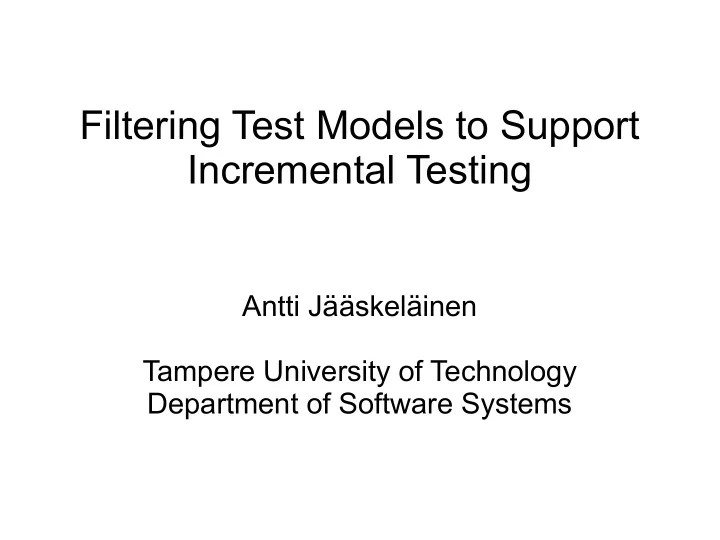

Filtering Test Models to Support Incremental Testing Antti Jääskeläinen Tampere University of Technology Department of Software Systems
Outline ● Background and Theory ● Filtering ● Connectivity Algorithm ● Example ● Conclusion
Background and Theory
Model-Based Testing ● Automates the generation of tests ● Tests generated from a formal test model ● Test model describes the functionality to be tested ● Off-line testing: tests are generated first and executed later ● Online testing: tests are executed as they are generated
Model Formalism ● Our models are LSTS (labeled state transition system) state machines ● Events encoded into actions (transition labels) ● State labels used for auxiliary information ● Models are strongly connected ● Test generation never ends in a deadlock
Parallel Composition ● Realistic systems are too large to model in a single state machine ● We create several smaller model components and combine them with parallel composition ● In parallel composition some actions of individual model components are executed synchronously ● For example, actions of the same name in different model components always executed together
Rule-based composition ● Synchronized actions defined explicitly ● For example {(a, √, 1a), (√, b, 2b), (c, c, c)} ● Rules for two model components ● First model component executes a alone as 1a ● Second model component executes b alone as 2b ● Both model components execute c together as c
Filtering
Motivation ● Models in product lifecycle ● Models can be completed before the SUT ● Complete test model may generate tests for features not yet implemented ➔ Unimplemented features must be avoided ● Bugs in the SUT ● Test execution terminates when a bug is found ● Until the bug is fixed, further tests may terminate in the same place ➔ Bugged features must be avoided
Solution ● Obtain a filtered view of the model with troublesome parts removed ● Performed by banning individual actions (and related transitions) ● Tests generated from the filtered model will not encounter unexecutable features
Retaining Connectivity ● Banning arbitrary actions can break strong connectivity ● Other actions must also be banned to restore the connectivity ● Test model may be too large for proper connectivity calculation ● Additional actions to be banned must be found by other means
Connectivity Algorithm
Purpose and Methodology ● Algorithm seeks to ban all actions whose execution may lead to violation of strong connectivity ● Based on four methods for finding actions to be banned ● Methods applied in turns until no further progress can be made ● Methods work on model components, not composed model
Actions Breaking Connectivity ● Actions leading out of the initial strong component (the strong component containing the initial state) must be banned ● The most important of the methods
Unreachable Actions ● Unreachable actions may be banned ● Not useful in itself, but may allow other actions to be banned later on
Actions without Rules ● Actions may be banned if there are no rules which allow their execution
Rules without Actions ● Composition rule may be removed if one of its actions is banned or otherwise unavailable
End Result ● Algorithm calculates an upper bound for initial strong component ● Some remaining actions may still break connectivity ● Modeler has to make sure that the bound will be accurate ● In our experience this is not difficult to ensure
Example
Conclusion
Results ● Filtering methodology can be used generate tests that avoid unexecutable functionality ● Models must be restored to strong connectivity when actions are removed; this can be mostly automated ● Some effort in modeling is required to ensure compatibility
Future Work ● Applying the filtering methodology to other forms of parallel composition ● Filtering non-behavioral models and data
Thank You
Recommend
More recommend